9 Ideas To Reduce Your Customer Churn Rate

How many customers do you lose each month?
Do you know that to attract a new client, businesses spend about 5 times as much as they do to retain an existing one? And yet, only 18% of businesses have a strategy for customer churn prevention. It looks like others choose to ignore this phenomenon, which may hinder their growth.
How To Calculate The Customer Churn For Your Company?
To put it simply, customer churn is the percentage of customers that have never returned to make another purchase. The higher the rate, the more customers stop doing business with you.
Now, let’s calculate some costs. Say your company acquires ten new customers each month and they each bought products and services worth $100. Assuming your churn rate is 0%, over 3 months your revenue will be ($100 X 10) + ($100 X 20) + ($100 X 30) =$6000.
With an average churn rate of 10%, you’ll have:
($100 X 10) + ($100 X 18) + ($100 X 27) = $5500.
Thus, a 10% churn will cost you roughly 10% of total income. Moreover, this calculation doesn’t take into account the cost of acquiring new clients and selling rate fluctuations.
To get an estimate, you have to segment your customer base by the frequency of purchases they make per year, and then calculate customer churn for multiple time intervals.
There are two ways to analyze the churn: cohort method and churn by behavior.
A cohort method involves dividing all customers into groups and estimates the churn rate for a specific group for a certain time interval. This method provides clear numbers and helps to determine the pattern.
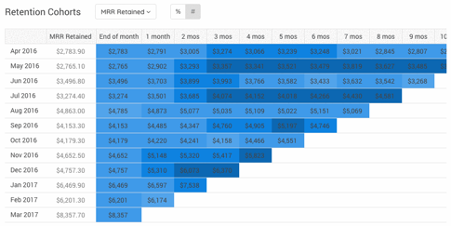
Source: Chargify
Churn by behavior focuses on identifying patterns of churn depending on customers’ certain actions or usage of certain features. This method helps businesses to decide on which products to focus, and what to improve.
Is There A “Good” Customer Churn Rate?
In reality, no matter how excellent your service is, you will lose customers. Let’s look at what statistics say about the average churn rate at B2B companies in different industries:
- Software-as-a-Service businesses lose about 4.6% of customers monthly;
- The media and entertainment industry experiences an average churn of about 6.2%;
- Healthcare services see a monthly churn rate of 4.0%;
- Education services show a rate of 5.1%.
The below graph presents the average churn rate for industries, including both B2B and B2C businesses. Generally, B2B experiences less churn due to complex purchase processes. However, the consequences of them losing a customer weigh more as it’s not just an individual lost — but an entire team of people. That stresses the importance of a complex approach to reducing customer churn.
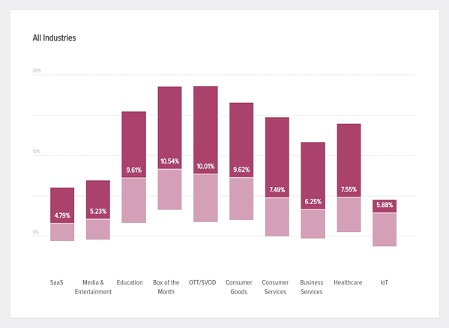
Source: Recurly
Now that you have estimated the “normal” customer churn for your business, let’s look at what you can do to stop losing customers:
1. Keep The Conversation Going
The popular reason why customers stop using your services is that they lose the feeling of connection. To keep them engaged, you need to encourage activity by reaching out to your audience every once in a while. Great help here proves to be messaging platforms and live chat software. In fact, with live chat, you can not only attract leads but also retain the existing customers, build up your loyalty around your company, and benefit in many other ways. Here’s how:
- Automated messages. You can create personalized messages that will be sent to certain people at the right time to show appreciation.
- Live chat app integration. If you have an app, you can take your customer support to the next level and enable them to get instant help.
- Gather feedback. Many live chat platforms offer tools for creating polls and surveys. Tracking clients’ satisfaction rates and taking timely action is another great way to reduce churn rate.
A data analytics service Vainu starts an immediate conversation through live chat. As a user enters the website, they are greeted by a pop-up window, and then the Vainu bot offers a tour into what their product can do for the visitor’s company. You have several options you can click on to get the information you need. Eventually, the bot will ask to leave the visitor’s email address that can be later used for targeting purposes.
Source: Vainu.com
2. Send Retention Emails
Acquiring new customers is much more expensive than retaining the ones you already have. After all, a currently inactive subscriber was once interested in your product or service. That makes it worth seeing if you can get them back before deleting them from your list. So, you need to come up with a customer retention email plan. This will be a series of emails designed to re-engage “sleeping” customers. An average email retention plan consists of the following types of emails:
- A welcome email to show courtesy.
- “Thank you” emails to show appreciation after a customer has made a purchase, provided feedback, or referred a friend.
- Special incentives emails for those who haven’t shown any activity for a while.
A great example of a retention email is this “We miss you” one by Teespring. It is personalized, speaks to a person’s emotional side, and reminds how successful the user was while using their product with a short summary.

Source: Teespring
3. Make Sure Your Messages Get Through
Sometimes your attempts to reach out to your clients simply don’t make it through other informational clutter. To improve your email deliverability, keep your content highly personalized and relevant to the recipient. Here are the crucial steps to do if you notice that your marketing effort goes in vain:
- Keep your database relevant. Many email providers mark repetitive unanswered messages as spam. So check your list regularly using email search and verification software and remove dormant addresses.
- Create different campaigns for different audiences. This goes hand in hand with personalization and knowing your customer to better cater to their needs.
- Let people unsubscribe. It is impossible to make everyone love your brand. Still, by giving your subscribers the option to opt-out, you reduce the number of clicks on the “Complain” button.
- Don’t send attachments. ISPs treat attachments as a potential hazard and are more likely to block your emails. Instead, give your subscribers a link to a landing page where they can download your content.
- Grow your email list. When done right, your customer base is constantly growing. Since people use different channels to discover your brand and buy products, it’s important to make sure that you have their contact details. For example, if you have an Instagram presence, it’s a good idea to collect emails from your Instagram followers as these people may get on your list during the discovery phase.
4. Spark Interest In At-Risk Customers
As soon as you have determined that a certain client may be about to stop using your services, treat them with a unique offer. Customers tend to respond well to personal offers that were prepared to solve their unique problems. Show that you know them, and see how your customer churn rate improves. Here are some ideas:
- Supportive benefits. Stay aware of what’s going on in your customers’ lives and be ready to respond with a timely offer. Has there been a storm? Is your client currently going through a financial crisis? Offer them a discount or even a free service that can help them out and be sure this will add up to their customer experience.
- Reminder about the loyalty program. If you have a segmented loyalty program, sometimes customers may lose track of their current status. Send them occasional reminders of what benefits they already have and how many steps are left to the next tier.
- Offer a time-limited discount. This works well for customers whose trial period had expired, but they never got a paid subscription. Those leads are likely to return if you can persuade them that the offer is exclusive for them.
During the COVID-19 lockdown, Fitnesshotline has joined the #StayHomeStayFit campaign on Instagram and encouraged their audience to continue workouts at home and share them on social media. What’s more, in their message, they told how exactly their fitness nutrition products were good for one’s health and offered 20% off.
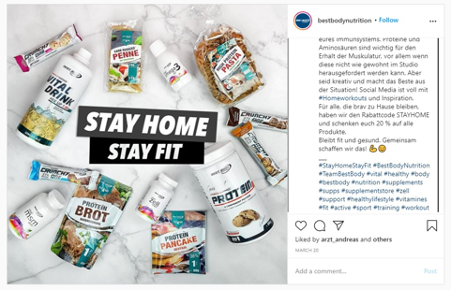
Source: Fitnesshotline Instagram
5. Show That You Are There For Your Customer
Sometimes websites go down, pages get lost, and payments fail. All that inevitably leads to churn. However, you can minimize the damage by notifying users that you know about the problem and have already taken measures to fix it. Here are some examples of ways to reduce customer churn using the so-called dunning emails:
- An email after a problem has been found and solved. With such a notice, you let your customers know that you monitor the processes and react to issues quickly.
- An apology for an on-site error and reassurance that the customer’s data is safe.
- A reminder about an abandoned shopping cart. Here you are showing care so that your customer wouldn’t find themselves lacking an essential item when the time comes. What’s more, that’s a perfect opportunity to educate them about your product, so they keep coming back.
- A notice about maintenance has been planned. If you are going to take any actions that may temporarily affect your website or app work, let users know beforehand. Before launching the maintenance, make sure that no one is working with your platform or that their changes will be saved.
This scheduled maintenance email by Notion is friendly and makes it easy to understand what is required from the recipient. While it gives clear instructions, this is more of a helpful message, not an order. You can see from the email that the company has done everything possible to ensure their clients’ work won’t be interrupted due to maintenance. On top of that, they have also provided sources for users to monitor the maintenance process.
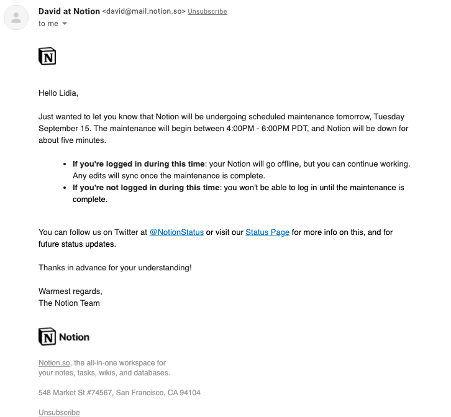
6. Adjust Your Content to Different Formats
Some people prefer long-read blog posts while others spend the most time watching videos. By repurposing your existing content and coming up with an effective social media promotion strategy, you make it easier for your audience to access the information. Let’s see how to reduce churn rate through marketing and make customers want to check on your website again and again:
- Delve into details. Before your clients can enjoy using your product or service to the fullest, they need to know all it can do. Create a self-service knowledge base, FAQs, and handbooks so they can see how valuable your product is.
- Post content in series. Instead of writing a post that briefly describes your product’s benefits, break it into chunks, and make a separate narrative around each. This way, you can capture customers’ attention each time the next article is published and shared. The strategy works for all types of content, from YouTube videos to blog posts.
- Use different channels for different audiences. If your business targets several groups of people, they might use different social media channels to get information.
Since BMW targets people in a relatively wide age range (35-50), they are present on all the popular social media channels. For Facebook and Twitter, they created several dedicated accounts for specific products. On Instagram, they highlight new features and post educational content. On LinkedIn, they run discussions and create brand awareness. For both promotional and educational purposes, the company uses YouTube and has recently appeared on TikTok.
7. Set Expectations For New Customers
With onboarding messages, you let your latest clients know what they can receive from your company and help them better understand how to use your services. Having conveyed your message right, you shape the customer experience and reduce churn by cutting unrealistic expectations.
From here, you also introduce them to your community by offering to join your social media channels. This is the perfect time to describe your product’s inspiring side and show the customer how to incorporate it into their lifestyle.
A mood board-making service Niice sends lovely welcome emails. It is personalized, gives a quick outline of how the service works, and describes the main benefits of using it.
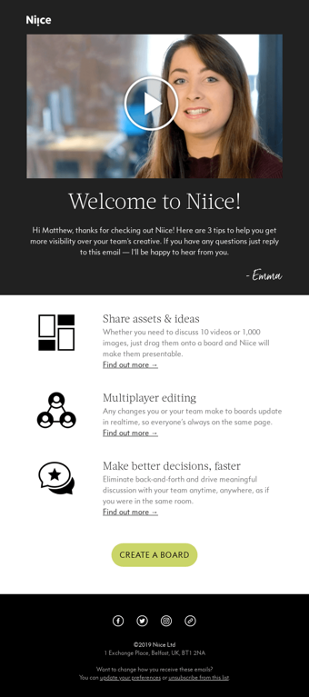
Source: Really Good Emails
8. Revise Your Prices
Lowest paying customers usually churn the most, thus ruining your statistics and taking up your client support’s time. Surprisingly, the research shows that cheap prices can sometimes be perceived as evidence of a low-quality product. There are three signs it’s time for your business to raise prices without affecting the churn rate:
- Positive comments. When you get multiple comments on how good your product is, this is your chance to reconsider its value.
- Increased activity. Every business has its high and low seasons. However, if you noticed that the engagement rate has risen, this might be the time to introduce price change.
- Competition. If your competitor research has shown that your prices fall out of the average range, it’s time to take action.
9. Collect Feedback And Use It To Get Better
By reaching out to customers, you can learn a lot about your weaknesses that may annoy them to the point of leaving. You can collect feedback in various ways:
- An opt-out form to fill as someone cancels their subscription.
- Asking questions after a customer turned to client support and the issue has been resolved.
- Regular client satisfaction surveys.
- Social media listening.
Pay attention to review platforms like G2 Crowd and Capterra, as both B2C and B2B customers tend to go there to discuss their experience with a certain company.
Feedback there is unstructured and visible to everyone. So the key is to spot and react to new comments in a timely manner – especially those with a complaint. Good news: on review platforms, you may guide the conversation and monitor the latest trends. Reply individually, or with links to your preferred channels of communication, and, of course, use the feedback to improve.
Next, after you have identified the major sources of the problem, think of the ways you can implement the features that appear to be missing. An eye-catching update of your clients about the innovation can significantly reduce customer churn.
Wrapping Up
When a customer turns inactive, it doesn’t mean you have to just let them go. Sometimes, all that they lack is a bit of personal interest. In other cases, you may learn about the drawbacks of your product that you never considered and use the feedback to improve.
 Lidia Bondarenko is a PR and outreach specialist at HelpCrunch, an all-in-one customer communication platform. Her professional experience encompasses customer service improvement, social media marketing, and SEO. Her free time she spends searching for new marketing trends and TV shows, and practicing yoga. Connect with Lidia on LinkedIn here. Tweet or follow her on Twitter @Liya_Bondarenko.
Lidia Bondarenko is a PR and outreach specialist at HelpCrunch, an all-in-one customer communication platform. Her professional experience encompasses customer service improvement, social media marketing, and SEO. Her free time she spends searching for new marketing trends and TV shows, and practicing yoga. Connect with Lidia on LinkedIn here. Tweet or follow her on Twitter @Liya_Bondarenko.
Sign Up For Our Mailing List
If you’d like to receive more in-depth articles, videos, and Infographics in your inbox, please sign up below

Sign up for the newest articles from Curatti, delivered straight to your inbox
Featured image: Origin unknown

CURATTI GUEST


